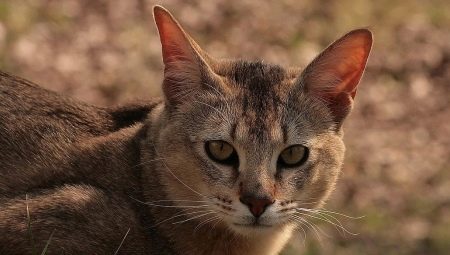Cats today are one of the most popular pets and are widely spread throughout the world. Moreover, globalization leads to the fact that people and their hobbies are becoming more and more similar, and it is becoming more and more difficult to stand out from the gray mass, because unusual breeds of pets that are able to surprise are in great demand. These are just the Chauseys, which are ranked among the most expensive cats in the world - instead of such an animal, it would be quite possible to buy a car.
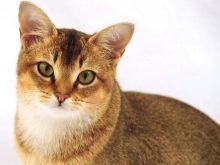
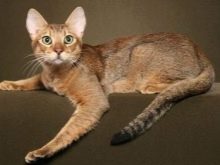

History and distribution
Most famous and famous breeds have a rather long history dating back at least several decades. This can not be said about Chauzy - this breed is not very well-known and certainly not old, with which, possibly, the crazy dearness of its representatives is connected - there are just so few such cats.
People have long liked small-sized wild cats - many find them more refined and attractive than ordinary domestic four-legged cats. To get a truly wild animal at home is not very convenient - sometimes it is protected by law, sometimes it just behaves inappropriately for a resident of the apartment. Another thing is a crossbreed that can occur if a domestic cat in certain regions is allowed to get acquainted with wild relatives.
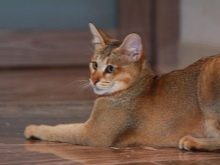
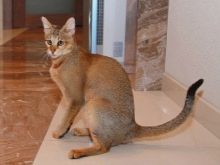

The reed cat is still found in many regions of Asia today - for example, it can be found on the Caspian coast of Russia, and it was this animal that gave the wild part of the blood to modern pets.
Interestingly, the breed was not raised at all here, but in America, where local breeders at some point became interested in curious looking kittens and decided to intervene in the natural course of events with their own adjustments.
The goal was peculiar: the end result was to look like a savage and have the same temperament, but at the same time be nice and homely. It turned out not bad, because in 2003 the breed was officially recognized, having received the name in honor of the reed cat, which is scientifically called Felis chaus.
At the moment, in America, Chauzy can no longer be called a rarity, but they reached the post-Soviet space literally in the form of single copies. This not only allows you to stand out with your own originality, but also allows you to make good money on breeding such animals.
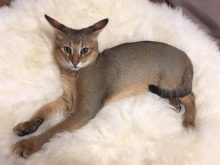


Description
Seeing the mention of a cat as a half-wild creature, not every catman will express a desire to get acquainted with this breed. However, the children of the reed cat are not as scary as you might have imagined.
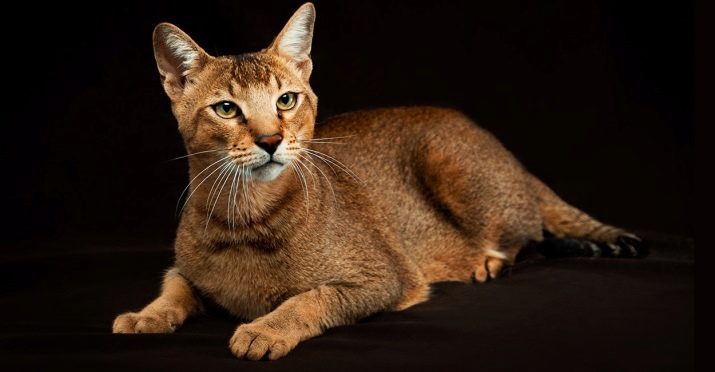
Appearance
The main characteristic of the breed is that visually they should substantially resemble their wild ancestors. In particular, the breed standards prescribe that the animal’s head, set on a short, but very powerful neck, should be small, with angular cheekbones and a powerful chin; it is decorated with an elongated nose of a straight shape. Above the skull is decorated with erect ears with tassels. The eyes of the predator are reminiscent in shape from those that the puma has - the incision is also slightly slanted, the eyes themselves are amber in color, although yellow, green and any mixed tones are also allowed.
The body of the predator has an elongated graceful shape with a deep chest. The massive torso rests on long and strong legs with fingers wide apart - this provides the animal with good stability. Crowned by a cat tail, whose length is almost equal to the length of the body.
Please note that such an animal is larger than the vast majority of domestic cats - an adult animal can easily weigh up to 15 kilograms.
In this case, the size of the female is noticeably smaller than that of the male, but she is more active and mobile.
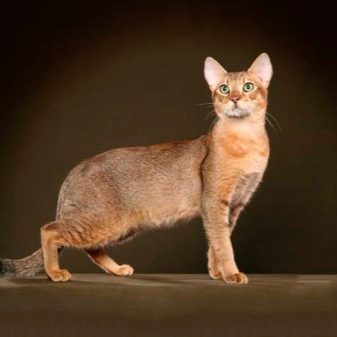

The wild origin affects the coat of the beast - it is very dense, but at the same time short, that is, it saves from the cold, but when moving it simply can not catch on obstacles. Chausi fur glistens, combing or any other shaping lends itself poorly.
A true representative of the breed is only three colors - black a la grizzly, as well as ticked silver or tabby. Such a cat simply cannot be completely monophonic, if so, that means they offer you a fake. In this case, the ear brushes and the tip of the tail will in any case be black, and the pattern is clearly visible only on the tail, legs and muzzle, while in other places it merges.
In fairness, it should be noted that the appearance of the chauzy is very much affected by how much “wild” blood is in it, but we will examine this aspect in detail a little later.
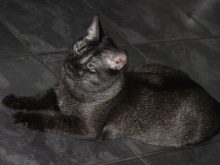
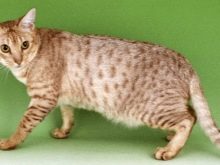
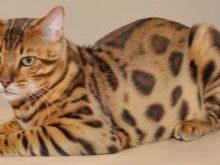
Character
The behavior of the Chauzy is a completely incredible mix of domestic and wild habits, so inexperienced cat-makers will certainly be shocked by some of the tricks of their unusual pet. However, it’s only more interesting. Do not worry, in general, it’s the same affectionate domestic cat that becomes attached to its owner and wants attention from him. Wildness manifests itself in another, and potential owners should be warned about this.
Unlike most domestic feline cats, the chauzy is completely not afraid of water, swims well and is curious about the prospect of hunting for various prey found on the surface of the water or in its thickness.
Also, representatives of this breed are interested in any elevations from where it is convenient to view the surrounding area, so do not be surprised if the pet will regularly climb onto a cupboard or a mezzanine, choosing a place under the ceiling.
Another "barbaric" habit of the animal is that it is stocked with food for a "rainy day." The fact that you feed your pet every day at the same time and carefully adhere to the selected schedule does not affect the situation at all - this is instinct, the cat just wants to be sure of tomorrow's house.He will try to hide his supplies so that no one will find them, but of course you will find them in the apartment sooner or later.
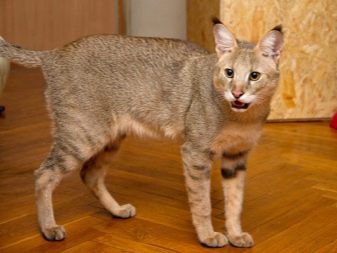
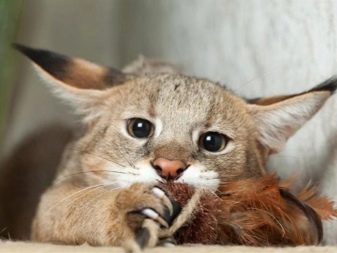
A curious feature of the breed is amazing sociability of these animals. This is absolutely not the kind of pet that normally perceives loneliness - someone’s company really needs a chauzy, and if the owner has stocked up, the beast will try to make friends with at least someone, even if it is a dog.
In addition, the predator’s inquiring mind needs periodic logical tasks, because the pet will not mind at all if you sometimes teach him various tricks - especially if you reward him for diligence and understanding.
Keep in mind that in the wild reed cats lead a very active lifestyle, because such a pet is not at all a homebody and not a quiet one.
When acquiring such a baby, immediately think about where there will be a sufficiently spacious place for his games - don’t take the risk of turning the whole house into a cat training ground. On the whole, experienced cat-keepers are inclined to think that for such a half-wild creature living in a private house with a large personal territory would be much more comfortable, but in the apartment it will be cramped.
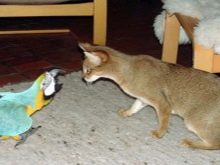
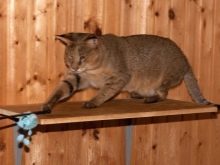
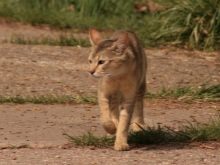
Varieties
Chauzi is a holistic breed, some smaller breeds are not distinguished among its representatives. Moreover, the population of these animals is heterogeneous, since in fact they are hybrids of wild reed cat and domestic cat. In the vast majority of cases, of course, the animal has more “home” blood, but in general, the classification of varieties is made precisely on this basis. Naturally, the differences between the different variants of the chausie are obvious - some of them are almost ordinary pets with a slight touch of wildness, others are a wild predator with minimal touch of manners.
In general, five classes of representatives of this breed stand out:
- F1 - at least half of the animal’s blood is “wild”, such pets are obtained if one of the parents was a purebred reed cat, or when two pets of the same class were mated;
- F2 - in such a cat, a purebred "savage" was perhaps just a grandfather, such pets appear when mixing an animal of class F1 with a cat of any other breed;
- F3 - the blood of the reed cat is no more than 1/8, such pets are already in many ways ordinary domestic cats, only affected by unusual wild impurities;
- F4 - 1/16 of the blood of a wild ancestor;
- F5 - 1/32 of savage origin, it is already almost impossible to determine from such an animal that it is thoroughbred and has characteristic roots.


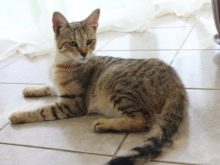
Breeding
In many ways, Chauseys are so expensive also because they are very difficult to breed. The fact is that in most cases, male kittens in the upper grades (primarily F1 and F2) are sterile from birth.
In practice, this means that the feline pair F1 does not have any cubs: the male will not give any offspring at all, and the female must be crossed either with a real wild reed cat or a male of a different breed, but then the cubs will be only of class F2.
For this reason independent breeding, and even in our conditions, where there are practically no chaushes, can be considered a matter of great complexity. The maximum that can be done is to breed a high-class cat with ordinary domestic cats, producing kittens of class F2 and lower. In general, the mating procedure is completely similar to the similar procedure in any other breeds, only it should be borne in mind that a semi-wild animal can offend a too timid and domestic cat.
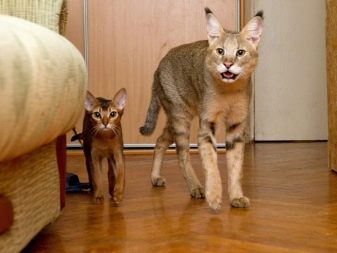
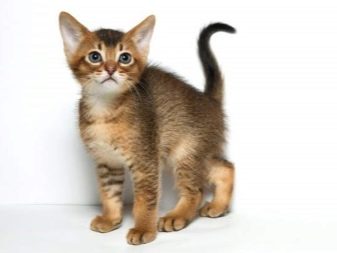
If you have a cat of high class, and you still decided to cross it with other breeds, please note that to preserve the color and most other pedigree traits, it is necessary to carefully choose a partner for mating. The best candidate is the representative of the Abyssinian breed, since it was he who was usually taken by breeders to cross with reed cats. As a possible, but still not the best alternative, Bengal cats and representatives of some short-haired breeds can act.
The big problem is that the “wild” genes in lower classes of cats are no longer dominant, because most kittens look completely ordinary at all, so they have to be carefully selected.

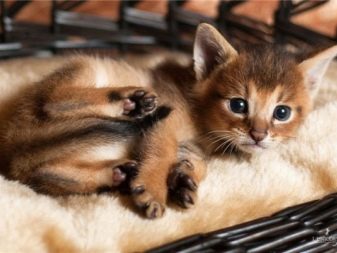
Content
As is clear from the foregoing, to get such a pet is not all, it is necessary to provide him with the correct conditions of detention, since the half-wild four-legged may need a completely different approach than the one that a typical domestic cat needs. If by any means you decide to acquire a Chauzy, you should first ask how to properly contain this miracle.

Parenting and training
In the wild, for the predator, not only strength, speed and agility are important, but also a developed mind that helps to build a strategy for catching prey. A real Chauzy is distinguished by excellent quick wit, because representatives of this breed are often praised for the simplicity of training - the pet understands the owner perfectly, easily grasps the relationship between the execution of commands and receiving rewards and then simply earns a living. For this reason, it is necessary from the very first day of stay in the house to clearly explain to the kitten where the cat’s toilet is and where the claw’s point is.
Even in childhood, babies are susceptible to learning, therefore it is better to immediately teach them the rules of life for adults than to retrain them later.
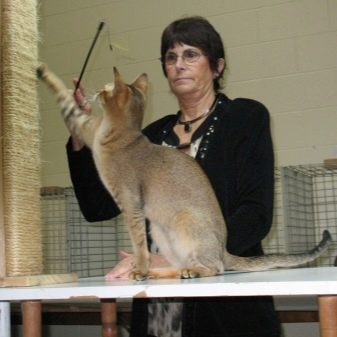
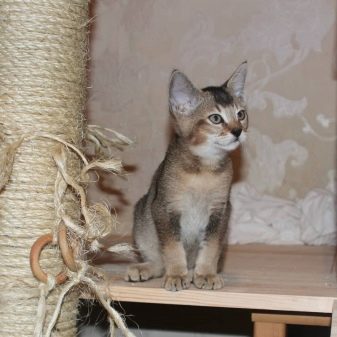
If you have long doubted who is best to get a cat or a dog, then a chauzy is probably the best solution for you, because the mind of this breed is enough to learn typical dog commands. A well-trained animal can not only sit down and lie down at the request of the owner, it also meows, gives a paw and even “dies” in a picture at the command of the owner. Rumor has it that such pets even know how to find and bring slippers to the owner - since the representatives of the breed do not differ in modest dimensions, this is not a problem for them.
If you have some experience in training and are ready to devote a lot of time to this, you can try to learn the animal and more complex tricks like dancing to the accompaniment of music or jumping through a hoop.
Unlike many other animals, chauses are not lazy at all in the process of training - on the contrary, they like the owner’s company and communication with him, they do their best to please him, and their sharp mind only helps them. The mustachioed predator is very persistent, and it is possible that he wants to learn a new trick even more than you would like to see him.
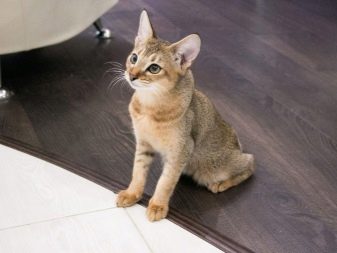
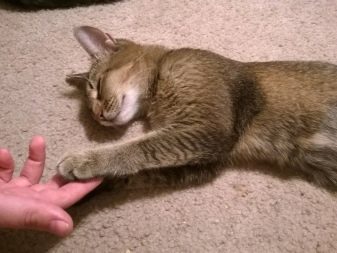
Care
The wild origin for the owners of such cats is very useful - in nature, animals somehow dispense with the help of humans, which was also transmitted to the domesticated version. In general, of course, you can and should take care of the pet’s health and appearance so that it looks good and feels the same, but it’s certainly not more complicated than with any other domestic cat.
For example, a dense coat of a pet needs to be combed out weekly - this will make the beast look more attractive.
In this case, it is advisable to choose not combs, the effect of which is not at all impressive, but massage brushes with soft bristles - they stimulate blood circulation, and therefore contribute to the growth of new shiny hair.
Naturally, when the animal sheds, and this usually happens in the summer, combing should be done more often, because otherwise the predator can unceremoniously scratch everything that it sees.
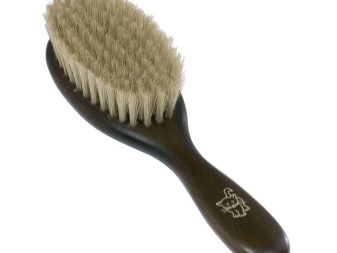

As stated above Chauzi is not afraid of water and sometimes he would like to swim, which greatly simplifies hygiene procedures. People with experience in keeping such animals at home say that you can bathe an animal quite often - usually it’s only glad to be able to swim.
The only thing to worry about is that during the drying period after the bath the pet does not get into the draft. In general, of course, this should not be a problem, because in the wild reed cats no one hides from drafts, but this is your favorite - you should not risk his personal health just because for someone this would not be a problem.
If you strive not only to let the animal swim, but also to completely wash it, use specially produced mild shampoos. It is not worth replacing them with “human” means - practice shows that from ordinary shampoos the cat's coat loses its brightness and weakens.
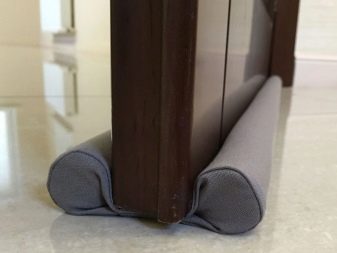
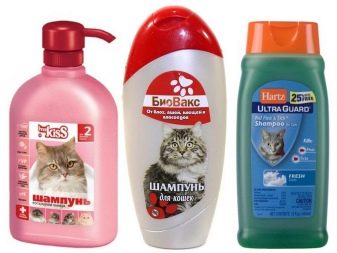
In all other respects, caring for a predator is simple: it is necessary to check the presence of sulfur in his ears at least once a week and remove it. As necessary, a similar procedure is done with the eyes - if mucus accumulates there, it should be removed as a medium for potential propagation of pathogens.
Ideally, an animal should be accustomed from childhood to daily brushing, or at least regular examinations of the oral cavity for various dental injuries and ailments. Finally, no clawfish can cope with the rapidly growing pet's claws on its own, so they need to be cut off periodically with a special secateurs - usually such a need matures about twice a month.
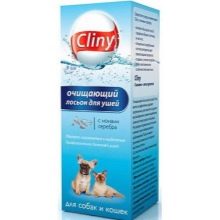


Speaking about the fact that Chausie is a half-wild animal, one must remember that for classes F1 and F2 this is not an exaggeration. Such pets are almost always kept not in the house, but in a special spacious enclosure on a personal plot, since the habits of the beast may be too incompatible with home living. If there is not so much wild blood in the pet’s body, a spacious apartment will be enough for him, but only on condition that the owners regularly walk him along the street with a collar, like a dog.


Diet
Feeding a chauzy is much more difficult than generally caring for it - too many people mistakenly believe that the semi-wild beast has a universal stomach that can digest absolutely everything, which, of course, is not true. It is possible that in the wild the reed cat does not eat balanced or properly, but there it is not fed with various harmful products that he himself would not have found, and even wild individuals usually do not live as long as well-groomed domestic animals.
Due to the fact that the wild roots of the Chausey are not so deep, the animal has a specific, purely predatory intestinal tract of relatively short length - this structure is completely unsuitable for digesting fiber in particular and plant foods in general. In this regard, representatives of this breed are even more vulnerable than any other domestic cats - even premium-class vaunted dry food for them is not considered good enough food.
In order not to make a mistake with the selection of the diet, it’s best to focus on what the reed cat would eat in the wild, that is, raw meat. Representatives of this breed have a very approving attitude towards rabbit meat, and there is also no objection to beef, although cows in the wild are unlikely to become prey for such small predators. Among other things, a small bird, such as chickens or quail, can be well received, however, cat food experts usually do not recommend pushing too hard on such ingredients.
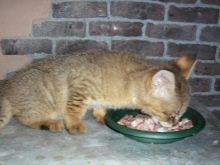


Wild reed cat swims perfectly and is able to hunt in the water, therefore, unlike many purebred cats, chausey is not only possible, but also sometimes needs to be fed with fresh fish. As an alternative, canned food but if you are feeding an unusual product for the first time, it is better not to give it too much - it is better to check if the animal is allergic to any components of such food.
In addition, boiled tendons or cartilage are also a valuable component of the diet - such food is good because it helps the cat “brush its teeth”.
Most of the other products, among which many often fall into a cat's bowl, are extremely undesirable or completely prohibited for a chausie. So, salty, fried and pickled - too unusual dishes for a wild cat’s stomach, such food will only cause indigestion, and salt will also provoke swelling of the tissues.
Sweets such cats are also undesirable - from them, pets easily gain weight, which is extremely negative for the cardiovascular system. For the same reason, representatives of the breed are usually not given pork in any form, and tea and especially coffee negatively affect the heart due to its stimulating effect.



Contrary to popular belief milk, which cats allegedly love, is undesirable for adult animals - as they grow older, they lose the ability to digest lactose, and when it enters the body, it only provokes an upset stomach. In addition, almost any plant food, including potatoes, legumes, nuts and even mushrooms, is completely superfluous in the cat menu.
There is not so much food in the wild, and you need to get it first, because representatives of this breed, getting to food, tend to eat as much as possible, so control the portion sizes, otherwise the beast will inevitably get fat. Chauseys are fed less often than other baleen pets - even babies are fed only twice a day, and once adults are often enough. Moreover, the cat over the age of one year, it will sometimes be useful to arrange an unloading day, when it generally remains without food or food will be unusually small.


Diseases, their prevention and treatment
The wild ancestors of the Chauzi were not pampered pets, so they passed on to their offspring a stern immunity that could defeat almost any infection on their own. The biggest problems for representatives of this breed are usually only obesity and problems with the digestive tract, and both threats are caused not by infectious causes, but by malnutrition. If you also took care of the timely vaccination of the pet, then there is little doubt that it is completely invulnerable to illnesses of any kind.
The grafting scheme is completely similar to that used for cats of other breeds. At two months of age, the baby is usually vaccinated against rhinotracheitis, calcivirus and panleukopenia, after a month the procedure is repeated, after which it is recommended to repeat the vaccination annually. In addition, you need to protect your pet from rabies - for this he is vaccinated twice during the first year of life.

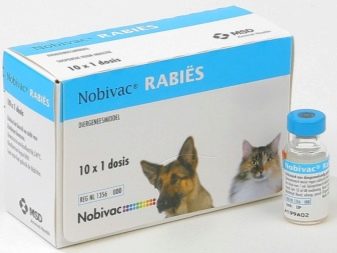
Vaccination usually involves a little preliminary preparation, which is that the animal needs to remove worms. For this purpose, there are anthelmintic drugs that are available separately for kittens - you must enter a similar remedy in the baby’s diet about one and a half weeks before the date of vaccination.
Please note that deworming for representatives of the Chausi breed, the main food of which is raw meat, will be a mandatory regular procedure throughout life.
The specific way of life of such a cat affects other areas of concern for his health. So, representatives of this breed need regular walks in the fresh air, where they certainly collect ticks and fleas. Even if a pet is, in principle, not allowed into the house, and because of the predatory nature of a purebred animal, you do not directly contact it, this does not mean that the problem can be left to chance.By treating the cat’s hair with special products from a veterinary pharmacy, you will ease its suffering and take care.
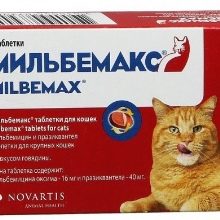
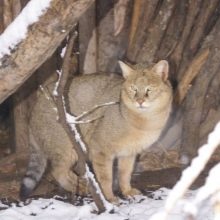

Selection tips
We have already figured out why the Chausi breed is so rare, now it remains to understand where to get the kittens. The best seller is a certified American nursery, but you should be mentally prepared for the fact that in rubles the amount will be at least six-digit and it will start far from one.
More often, a thoroughbred animal can be bought from owners who themselves breed animals, and there the price will be “only” five-digit, but be prepared that there is no certification, which means that fraud is likely. In addition, private breeders, of which there are no more than a dozen with official status in the world, live mainly in the West, and those of our compatriots who want to consider themselves as such will, at best, sell you an animal of class F3.


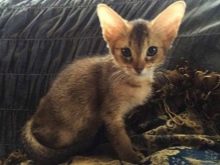
By the way, many of our compatriots are susceptible to sudden and in no way justified discounts, because in the phrase about an elite, but inexpensive animal, they are not confused by anything. There are quite a lot of cases of fraud, cunning businessmen use the gullibility of inexperienced customers, so be careful.
If you are offered a cat that doesn’t look much like a chauzy for relatively modest money, referring to its class F5, then this situation seems even more believable than selling a real purebred animal for a lot of money, but without documents.
Ordinary murks sometimes have a rather predatory appearance, but sooner or later the deception will be revealed, therefore, with a significant amount required, be sure to insist on obtaining documents confirming thoroughbredness and admission to exhibitions.
It is best to purchase such an animal at the age of 3 months, when it is still small, but already quite independent. A healthy baby, who does not bother anything, is characterized by normal children's playfulness, he is active and curious. If the kitten is not ill with anything, it should have a pleasantly shiny coat, and no extraneous discharge from the nose or eyes should be observed.
When buying a baby at 3 months of age, you have already missed the stage when the kitten needs to be vaccinated - which means that this obligation was placed on the breeder's shoulders. If he is conscious and did everything on time, let him show the relevant documents, if vaccinations were not done in a timely manner, think about the appropriateness of the purchase.
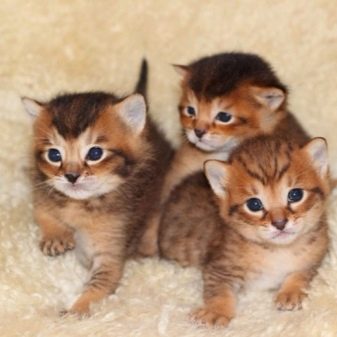
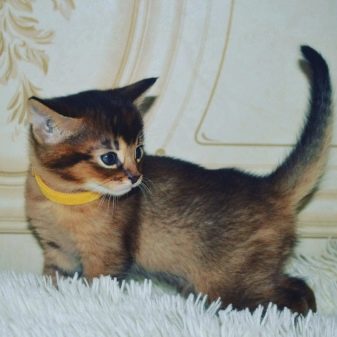
Read more about cats of the Chausi breed see below.
